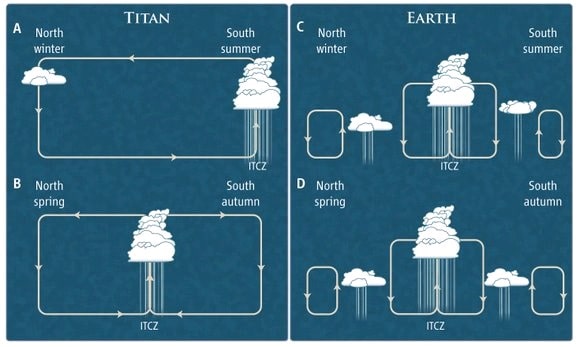The sky of Titan (Saturn's moon) rains a deluge of methane on the strange moon for a quarter of the year, rain that accumulates in its northern methane lakes and preserves channels and swamps that until recently were thought to have formed in the rainy era.

The sky of Titan (Saturn's moon) rains a deluge of methane on the strange moon for a quarter of the year, rain that accumulates in its northern methane lakes and preserves channels and swamps that until recently were thought to have formed in the rainy era.
Researcher Elizabeth Turtle of the Applied Physics Laboratory at Johns Hopkins University is the lead author of a new paper published in the prestigious journal Science which reports that it appears that Cassini (a spacecraft sent by NASA and the European Space Agency to study the planet Saturn and its moons, The entry in Wikipedia) was able to detect a storm during its operation last year: "We reported Cassini's discovery of the science subsystem imaging of an extensive group of low-Rome clouds early in Titan's northern spring and of extensive surface changes," the researchers describe.
"The most consistent changes are of diffuse methane showers reaching the ground, showers that suggest the dry channels observed in Titan's low elevations are formed by seasonal precipitation."
While Saturn's largest moon contains high bromine methane lakes, the equatorial regions are mostly arid and include vast expanses of sand dunes. Researchers first located arid wadi-like channels in these areas with the help of images obtained from the Huygens probe (Wikipedia entry), and the popular explanation was that they were remnants of a rainy climate that existed in the moon's past.
The researchers noticed a significant decrease in surface brightness at Titan's equator after cloud eruptions. The scientists considered a number of possible explanations for these changes, including wind storms and a volcanic eruption, but they concluded that the most likely possibility responsible for the observed darkening was precipitation originating from a large methane storm that occurred in this area. The researchers note that the surface changed after the storm spread over an area of more than half a million square kilometers, the size of the state of California.
In another article in the field, a scientist from the University of Cologne reported that the sedimentary climate of Titan "is clearly different from that of the Earth, and it is possible that there may exist unknown exotic climate regions according to the Köppen method, a method for sorting regions of the world according to the prevailing climate, named after Vladimir Capen). The researcher writes that while global climate cycle patterns on Earth focus on precipitation that appears in rain bands along the equatorial regions, it appears that Titan's "convergence zone" has migrated slightly north and south over time, receiving precipitation that is more evenly distributed over the surface of the moon.
The news about the research in Universe Today


7 תגובות
I don't understand then what is the temperature required to turn methane into gas? or solid?
Cooking gas: it is so cold there, that the methane is liquid and not gaseous. Water appears in the form of ice, like rocks on Earth.
of Saturn of course.
"While Titan's largest moon contains high bromine methane lakes, the equatorial regions are mostly arid and include vast expanses of sand dunes."
What is Titan's largest moon?
I always said.. who wants to be a star... to be distant and full of gas...
(even though it's a moon.. I know)
So basically Titan is one giant cooking gas balloon.
It would be fascinating to send a motorized robot or UAV to Titan and receive its products